The global time switch market is estimated to grow from USD 2.65 billion in 2025 to USD 4.23 billion by 2035, marking an absolute value addition of USD 1.58 billion, which reflects a total growth of 59.6% over the decade. This translates into a compound annual growth rate (CAGR) of 4.8%, with the market expected to expand nearly 1.6X between 2025 and 2035.
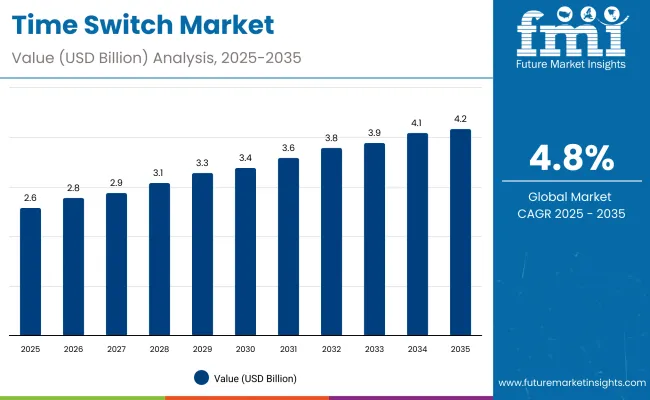
| Metric | Value |
|---|---|
| Industry Size (2025E) | USD 2.65 billion |
| Industry Size (2035F) | USD 4.23 billion |
| CAGR (2025 to 2035) | 4.8% |
During the initial forecast window from 2025 to 2030, the market is anticipated to increase from USD 2.65 billion to USD 3.49 billion, resulting in an incremental gain of USD 840 million. Growth in this period will likely be driven by heightened adoption of programmable and IoT-enabled time switches for energy management in commercial buildings, automated HVAC systems, and lighting control. The proliferation of smart grid infrastructure and retrofitting activities in developed markets is expected to support upgrades from legacy mechanical timers to digital programmable modules.
Between 2030 and 2035, the market is forecast to scale further from USD 3.49 billion to USD 4.23 billion, adding approximately USD 740 million in value. Demand during this phase will be influenced by deeper penetration of energy efficiency mandates, adoption of wireless and remote-control features, and growing integration of time-based automation in industrial equipment. Manufacturers are likely to emphasize modular designs compatible with DIN rail, panel, and plug-in configurations, especially across Asia Pacific and Latin America.
Between 2020 and 2025, the global time switch market expanded steadily from USD 2.23 billion to USD 2.65 billion, registering an absolute increase of USD 420 million, equivalent to a growth of 18.8% over the five-year period. This translates into a compound annual growth rate (CAGR) of 3.5%. The market demonstrated resilience amid global supply chain disruptions, supported by sustained infrastructure investments, retrofitting initiatives, and energy efficiency programs in developed economies.
Leading players introduced compact, modular designs with increased relay capacity and DIN rail compatibility. Adoption was particularly strong in retrofitting projects, where older electromechanical timers were replaced by programmable switches with LCD displays and memory backup. By 2025, the market had reached a baseline of USD 2.65 billion, setting the stage for accelerated adoption of IoT-enabled and cloud-synced solutions in the years ahead.
The time switch market is witnessing sustained growth due to the convergence of energy efficiency demands, smart building integration, and automation-driven infrastructure modernization. As global industries move toward energy-conscious operations, programmable time switches are being adopted widely to minimize unnecessary power consumption by automating lighting, HVAC, and motor operations.
One of the most prominent drivers has been the need for precise load control in commercial and residential buildings, where time switches are integrated into circuit panels to automate indoor and outdoor lighting schedules. Utilities and facility managers increasingly rely on programmable time-based systems to reduce manual interventions, streamline operations, and meet stringent efficiency targets.
The growing penetration of IoT-enabled devices and the shift toward connected infrastructure is also enhancing the relevance of digital time switches. Manufacturers are embedding wireless connectivity, app-based controls, and programmable logic into their devices, allowing real-time remote configuration, time synchronization, and energy monitoring.
Urban expansion and renovation of aging electrical infrastructure in Europe and North America have created new opportunities for time switch retrofits. In parallel, industrial automation trends in Asia-Pacific are boosting the deployment of programmable switches in pump control, conveyor systems, and fan operations.
Regulatory push for daylight harvesting, load shedding, and peak demand control further supports adoption. Programmable astronomical timers are gaining traction as they adjust automatically based on sunrise and sunset, aligning with sustainability goals and reducing energy waste.
The market is segmented by product type into digital and analog variants, offering varied control precision and programming capabilities. Functional classifications include astronomical, cycle, and countdown timers, each serving different use cases in lighting, HVAC, and process automation. Connectivity options are categorized into standalone and IoT-enabled systems, reflecting varying degrees of integration with smart infrastructure. Installation modes span DIN rail, panel mount, plug-in, and wall-mount configurations, enabling use across residential, commercial, and industrial setups.
Based on operation, both manual and automated time switches are available, catering to different user control preferences. Applications cover a broad range, including lighting control, HVAC systems, water pumps, industrial motors, and appliances. This segmentation supports targeted deployment across utility, building automation, and energy management environments.
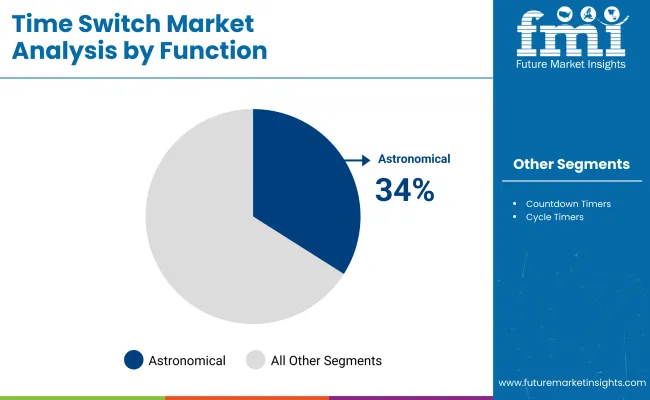
Astronomical time switches are estimated to hold 34% of the market share in 2025 and are projected to grow steadily through 2035. Their popularity stems from their ability to automatically adjust switching times based on sunrise and sunset, eliminating the need for manual seasonal changes. This feature supports energy efficiency and simplifies outdoor lighting control, especially in commercial and municipal environments. Adoption is increasing in street lighting, signage, and parking lot applications, where consistent and automated light operation is essential.
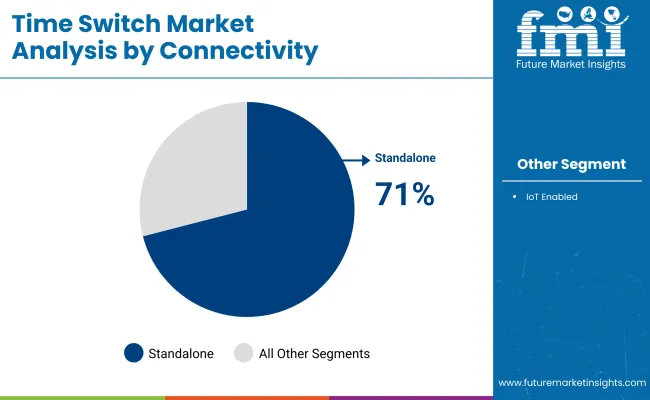
Standalone time switches are projected to account for 71% of total demand in 2025, reflecting a strong preference for simple, reliable, and cost-effective solutions. These units operate independently without network connectivity, making them ideal for retrofitting in legacy electrical systems or in regions with limited IoT infrastructure. Their widespread use spans residential, commercial, and industrial settings, where basic automation suffices, and minimal maintenance is preferred. Their affordability and ease of installation continue to fuel volume consumption globally.
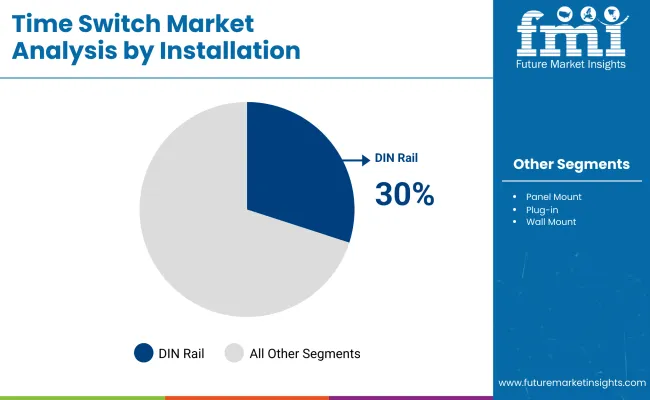
DIN rail installation is expected to contribute 30% to total market share in 2025, driven by its compatibility with modular electrical panels and ease of integration in industrial control systems. These switches are commonly used in manufacturing, utilities, and large-scale building automation setups. Their standardized dimensions and secure mounting reduce setup time and allow flexible reconfiguration of electrical enclosures. Adoption remains strong across both OEM panel builders and retrofitting markets.

Manual time switches are estimated to represent 58% of market revenue in 2025, driven by their ease of use, lower cost, and suitability for low-complexity applications. These switches are especially favored in residential and small commercial applications where programmable automation is not necessary. Users appreciate their tactile feedback and simple dial or push-button controls. Despite the growing availability of automated alternatives, manual models continue to serve customers prioritizing reliability over digital functionality.
Lighting control is projected to represent 34% of the total time switch market by 2025, supported by widespread use in both indoor and outdoor lighting systems. These include commercial buildings, homes, street lighting, signage, and architectural illumination setups. Time switches help reduce energy usage by automating on-off cycles based on user-defined schedules or astronomical events. The growing emphasis on energy-efficient infrastructure upgrades and smart lighting retrofits continues to support the segment’s growth across urban and semi-urban regions.
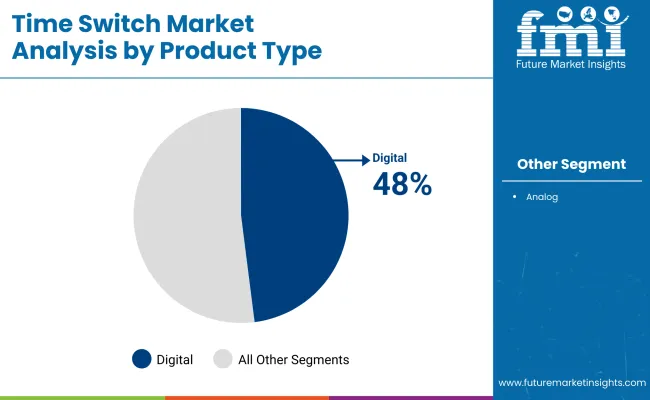
Digital time switches are estimated to hold 48% of the market share in 2025, driven by their precision, flexibility, and advanced scheduling capabilities. These products enable users to program multiple on-off cycles with greater accuracy, suiting commercial and industrial applications. Features such as LCD displays, memory backup, and programmability through mobile apps or keypads contribute to their broad utility. As demand for smart, programmable controls rises, digital variants continue to replace analog counterparts in retrofit and new-build installations.
Growth in the time switch market continues to be steered by automation-centric upgrades across residential, commercial, and industrial segments. Demand patterns are increasingly influenced by energy efficiency mandates, digitalization of infrastructure, and product innovations aimed at connectivity, safety, and ease of use.
Rising Adoption in Smart Infrastructure Projects
Government-led and private smart building initiatives have significantly boosted the adoption of time switches for lighting and HVAC automation. These devices are being deployed to schedule appliance operations, thereby reducing idle energy consumption and extending equipment lifespan. Urban infrastructure projects in Europe, India, and the Middle East are promoting programmable time switches to align with low-carbon and green building certifications.
Shift from Analog to Digital Systems
A clear trend is emerging toward replacing traditional analog time switches with advanced digital variants. Digital systems allow users to set complex programming schedules, integrate daylight savings adjustments, and operate multiple circuits through a single device. This transition is being accelerated by smart grid deployments and greater availability of programmable logic-based controllers in industrial control panels.
Growth of IoT-Enabled Devices in Energy Management
IoT-enabled time switches with wireless communication capabilities are redefining energy scheduling. Integration with building automation systems (BAS), mobile apps, and cloud dashboards allows real-time monitoring, remote scheduling, and predictive maintenance. These smart time switches are being adopted by commercial property developers and facility managers for distributed lighting and appliance control.
Expansion in Utility and Outdoor Applications
The use of astronomical and countdown timers is expanding across street lighting, water pumps, and outdoor signage. Municipalities and facility managers are investing in these systems to automate dusk-to-dawn lighting and irrigation schedules. Battery backup, tamper resistance, and auto-adjust features are becoming standard across high-volume outdoor time switch deployments.
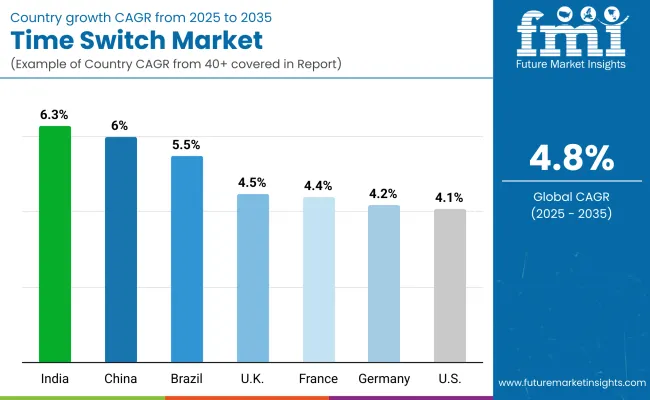
The time switch market across Europe is projected to expand from USD 660.4 million in 2025 to USD 994.5 million by 2035, reflecting a compound annual growth rate (CAGR) of 4.2%. Germany is expected to retain its market dominance, accounting for 25% of the regional market in both 2025 and 2035. France, the UK, and Italy follow closely, each representing over 11% of the share, driven by consistent upgrades in building automation systems and energy compliance policies.
The Rest of Europe is expected to hold a stable contribution of over 22%, indicating rising demand in Central and Eastern European nations. Spain’s share is projected to rise slightly from 8.0% to 8.4%, supported by demand for smart irrigation and outdoor lighting time switches.
India is expected to exhibit the fastest growth among major economies, with a CAGR of 6.3% during the forecast period. Rapid expansion of infrastructure, rising smart city deployments, and increased integration of automated HVAC, lighting, and pumping systems across commercial and residential sectors are driving demand for programmable and IoT-enabled time switches.
China’s time switch market is forecast to grow at 6.0% CAGR through 2035. Industrial automation, grid modernization, and rapid urban expansion are enabling strong adoption of time control devices, especially in manufacturing hubs and smart city zones.
Brazil is projected to record a 5.5% CAGR, driven by the increasing penetration of automation in commercial and industrial buildings. Demand is rising for smart control of lighting, security, and HVAC systems in mid-sized urban centers.
The UK is set to expand at a CAGR of 4.5%, supported by retrofitting of older infrastructure with smart control systems. Time switches are increasingly used in lighting, signage, and heating control in both private and public buildings.
France is anticipated to register a 4.4% CAGR. Automation of residential heating systems and increasing usage of DIN rail time switches in multi-dwelling units are the main contributors to this steady expansion.
Germany’s time switch market is projected to grow at 4.2% CAGR. Expansion in industrial automation, paired with large-scale municipal lighting programs, continues to generate demand for both panel-mount and plug-in time switches.
The USA market is forecast to grow at 4.1% CAGR. Growth is influenced by the continued integration of programmable time switches into smart home systems, particularly in lighting and outdoor applications.
In Japan, analog time switches currently hold a marginal lead, accounting for 52.0% of the total market value in 2025, translating to approximately USD 75.8 million out of the total USD 145.8 million. However, digital variants are steadily gaining popularity and represent 48.0% of the market. The transition is being supported by increased adoption across commercial lighting, HVAC control, and IoT-enabled appliances, where digital flexibility and precision are preferred. Government energy efficiency mandates are also encouraging facility operators to shift from legacy analog setups to programmable digital alternatives, especially in high-density residential zones.
Key Highlights:
In South Korea, countdown timers dominate the functional segmentation of the time switch market in 2025 with a 41.0% share, amounting to nearly USD 34.8 million of the total USD 84.8 million market. Astronomical timers follow at 32.0%, while cycle timers hold a 27.0% share. Countdown timers are widely integrated in residential buildings, consumer appliances, and low-voltage industrial setups due to their ease of installation and user-configurable scheduling. Astronomical timers are preferred in smart city infrastructure and commercial lighting owing to their automatic dusk-to-dawn operation.
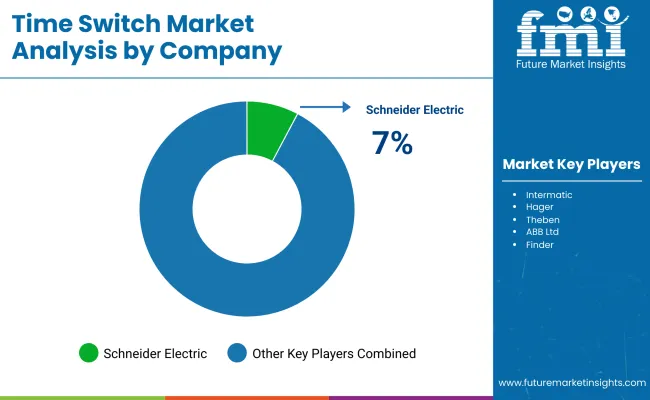
Competition in the time switch market is being shaped by the introduction of versatile, energy-efficient, and programmable solutions. Companies are focusing on devices that integrate astronomical timing functions, multi-output scheduling, and automation capabilities to enhance operational efficiency across lighting, HVAC, and industrial systems. The landscape is increasingly competitive as manufacturers emphasize user-friendly interfaces, customization options, and smart scheduling to meet commercial and residential energy management needs.
| Item | Inclusions |
|---|---|
| Quantitative Units | Market Value (USD Billion), Market Volume (Units) |
| By Product Type | Digital, Analog |
| By Function | Astronomical, Cycle Timers, Countdown Timers |
| By Connectivity | Standalone, IoT Enabled |
| By Installation | DIN Rail, Panel Mount, Plug-in, Wall Mount |
| By Mode of Operation | Manual, Automated |
| By Application | Lighting Control, HVAC Systems, Water Pumps, Industrial Motors, Security Systems, Appliance Controls, Open/Close Systems, Others |
| By Regions | North America, Latin America, Eastern Europe, Western Europe, East Asia, South Asia & Pacific, Middle East & Africa |
| Key Countries | USA, Canada, Mexico, Brazil, Germany, Italy, France, UK, Spain, BENELUX, Nordics, Russia, Hungary, Poland, India, China, Japan, South Korea, Turkiye, South Africa, GCC Countries |
The market is broadly segmented into Digital and Analog time switches, with digital models favored for smart automation and programmability.
Astronomical time switches hold the largest share (~34%) due to their ability to automate based on sunrise and sunset, while cycle and countdown timers serve repetitive and event-based needs.
Connectivity options include Standalone and IoT-enabled switches. IoT-enabled devices allow remote monitoring, smart scheduling, and integration into building automation systems.
Common installation types are DIN Rail, Panel Mount, Plug-in, and Wall Mount, selected based on industrial, commercial, or residential applications.
Time switches operate either Manually or Automatically, with automated solutions providing higher energy efficiency and operational convenience.
Leading applications include Lighting Control, HVAC Systems, Water Pumps, Industrial Motors, Security Systems, Appliance Controls, and Open/Close Systems, reflecting growing automation across residential, commercial, and industrial sectors.






Our Research Products

The "Full Research Suite" delivers actionable market intel, deep dives on markets or technologies, so clients act faster, cut risk, and unlock growth.

The Leaderboard benchmarks and ranks top vendors, classifying them as Established Leaders, Leading Challengers, or Disruptors & Challengers.

Locates where complements amplify value and substitutes erode it, forecasting net impact by horizon

We deliver granular, decision-grade intel: market sizing, 5-year forecasts, pricing, adoption, usage, revenue, and operational KPIs—plus competitor tracking, regulation, and value chains—across 60 countries broadly.

Spot the shifts before they hit your P&L. We track inflection points, adoption curves, pricing moves, and ecosystem plays to show where demand is heading, why it is changing, and what to do next across high-growth markets and disruptive tech

Real-time reads of user behavior. We track shifting priorities, perceptions of today’s and next-gen services, and provider experience, then pace how fast tech moves from trial to adoption, blending buyer, consumer, and channel inputs with social signals (#WhySwitch, #UX).

Partner with our analyst team to build a custom report designed around your business priorities. From analysing market trends to assessing competitors or crafting bespoke datasets, we tailor insights to your needs.
Supplier Intelligence
Discovery & Profiling
Capacity & Footprint
Performance & Risk
Compliance & Governance
Commercial Readiness
Who Supplies Whom
Scorecards & Shortlists
Playbooks & Docs
Category Intelligence
Definition & Scope
Demand & Use Cases
Cost Drivers
Market Structure
Supply Chain Map
Trade & Policy
Operating Norms
Deliverables
Buyer Intelligence
Account Basics
Spend & Scope
Procurement Model
Vendor Requirements
Terms & Policies
Entry Strategy
Pain Points & Triggers
Outputs
Pricing Analysis
Benchmarks
Trends
Should-Cost
Indexation
Landed Cost
Commercial Terms
Deliverables
Brand Analysis
Positioning & Value Prop
Share & Presence
Customer Evidence
Go-to-Market
Digital & Reputation
Compliance & Trust
KPIs & Gaps
Outputs
Full Research Suite comprises of:
Market outlook & trends analysis
Interviews & case studies
Strategic recommendations
Vendor profiles & capabilities analysis
5-year forecasts
8 regions and 60+ country-level data splits
Market segment data splits
12 months of continuous data updates
DELIVERED AS:
PDF EXCEL ONLINE
Time-Lapse Embryo Incubators Market Size and Share Forecast Outlook 2025 to 2035
Switchgear for Data Centers Market Size and Share Forecast Outlook 2025 to 2035
Time Temperature Indicator Labels Market Size and Share Forecast Outlook 2025 to 2035
Time Temperature Indicator Label Industry Analysis in Western Europe Size and Share Forecast Outlook 2025 to 2035
Switchrack Assemblies Market Size and Share Forecast Outlook 2025 to 2035
Switching Residential Voltage Regulator Market Size and Share Forecast Outlook 2025 to 2035
Switching Commercial Voltage Regulator Market Size and Share Forecast Outlook 2025 to 2035
Time Sensitive Networking TSN Market Size and Share Forecast Outlook 2025 to 2035
Time Of Flight Cameras Market Size and Share Forecast Outlook 2025 to 2035
Switching Mode Power Supply Market - Growth & Forecast 2025 to 2035
Time of Flight (ToF) Sensor Market Insights - Growth & Forecast 2025 to 2035
Switched Reluctance Motors Market Growth - Trends & Forecast 2025 to 2035
Switchgear Market Growth - Trends & Forecast 2025 to 2035
Evaluating Time Temperature Indicator Labels Market Share & Provider Insights
Antimetabolite Drugs Market Size and Share Forecast Outlook 2025 to 2035
Altimeter Market
AC Switchgear Market Size and Share Forecast Outlook 2025 to 2035
RF Switches Market Size and Share Forecast Outlook 2025 to 2035
DC Switchgear Market - Size, Share, and Forecast 2025 to 2035
Multimedia Projectors Market Analysis – Growth & Industry Trends 2023-2033

Thank you!
You will receive an email from our Business Development Manager. Please be sure to check your SPAM/JUNK folder too.
Chat With
MaRIA